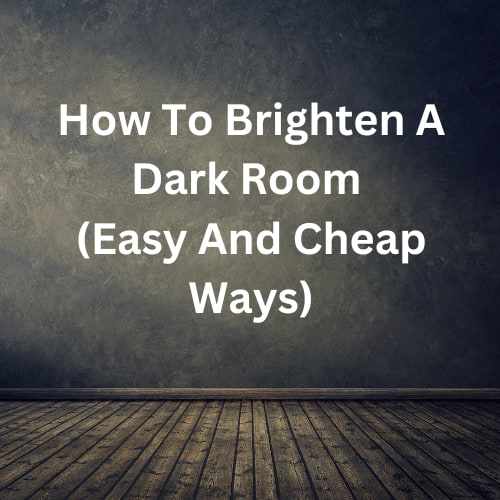How To Brighten A Dark Room (Easy And Cheap Ways)
We show you how to brighten a dark room easily and cheaply using the natural light coming in from the window.
This post may contain affiliate links, I earn from qualifying purchases at no extra cost to you. Click here for my disclosure policy
Your home should always be your place of comfort. It should be a space where you can truly relax. Having a home that feels welcoming as soon as you step in through the door is a source of great joy. But creating a home that leaves you feeling relaxed and comforted does take effort. The chances of finding a home that already perfectly matches your chosen aesthetic is pretty rare. This means that you’ll probably need to put some work in to create your perfect space.
Making over your home so that it feel light and airy will make it an appealing place to spend your time. Homes that feature plenty of natural light are often sought after by potential buyers. This makes natural light in the home a great feature for you while you live in the property. It also means that your home is likely to hold more appeal to prospective buyers – great news if you decide to sell it in the future.
As well as boosting your home’s appeal, natural light has further benefits. One of the main reasons that homeowners work hard to introduce more natural light is because of the well-being boost it delivers. Natural light can help to lift your mood. Plus, it’s especially helpful to people who suffer from seasonal affective disorder (SAD).
The many benefits of enhancing the natural light in your home are clear to see. But what you need to know is how can you make your home feel lighter. Take a look at these tips to find out:

How To Brighten Dark Room Ideas
Choose Your Color Scheme With Care
Your choice of color scheme is always a huge consideration when creating your perfect home. After all, color has the power to completely dominate a space. When you’re hoping to create a light and airy home, your color scheme matters even more.
White walls and furnishings are the obvious choice for a home that maximizes light. This is because white is the best shade for reflecting light. But you don’t need to stick with white. Most muted, paler shades of paint will help to keep your room looking light and bright.
Before you commit to a particular paint color, make sure you check it’ll work in your space. Chances are the color will look very different depending on the light source. While the color may look perfect when using artificial light, it may look too harsh in natural daylight. So, be sure that you get a sample and check how it looks in different lighting in your home.
If you’ve picked a color that you love for your rooms, you could choose to make even more of the light in the room. This is something you can do by using specialist light-reflective paint. Alternatively, you could simply choose a paint that has a sheen to it, such as gloss paint. This will also help your room to look lighter and brighter.
Let More Light In
Letting more light into your home is the obvious choice to make it brighter in your rooms. Having small windows or windows in the wrong position can mean your home is left looking dark inside. This is frustrating, as no matter how hard you try to introduce more light, your attempts may fail.
Having a builder install larger windows in your home or improving the window position is one option. An alternative solution that delivers tons of natural light to your room is to install a lantern window. These stylish windows are a real feature of your home. They act as a focal point for the room and are an excellent way to introduce huge amounts of daylight. The shape and positioning of the glass in a lantern window help to maximize the amount of light that floods in. Adding a lantern window to your home could cost less than you imagined. You can visit this supplier to discover some of the materials needed to create your lantern window at home.
Pick the Perfect Accessories
Adding some extra light to your rooms with your color scheme is super helpful. However, there are further ways that you can help your home appear lighter. One excellent way to achieve a light and airy look at home is with your accessories.
Home accessories are often seen as an afterthought. Many people think of home accessories as an optional extra that simply adds a finishing touch to the room. When you’re attempting to create a room that’s filled with light, your accessories are a big deal.
Choosing the right accessories can help you maximize the light in your rooms. The first accessory to consider is your window dressing. Big, heavy curtains are really helpful to keep the light out when you sleep. But thick curtains hanging in your window can also obstruct some of your daytime light. To counter this issue, you may want to choose a blackout blind for your windows instead. This means that during the daytime, the blind is rolled up, and the sun can shine fully into the room without being obscured.
Another accessory that will help you to make your rooms feel lighter is mirrors. Adding mirrors to your room is a great way to make it look lighter and brighter. The other massive benefit of using mirrors in your room is that they create the illusion of space. So, your rooms will feel much bigger with the careful placement of mirrors to help.
Brightening By Room Considerations
Brightening a dim living room can transform it from a dark cave into a welcoming space filled with a soft glow. Interior designers often recommend a combination of strategic choices to achieve this effect. Start with the walls; consider using light-colored wallpaper or opting for a fresh coat of warm white or high-gloss white paint. These choices create a light background that reflects as much light as possible, helping to eliminate the feeling of a dim room.
In terms of furniture pieces and décor, choose items with lighter hues to further enhance the brightness. Incorporate white or light-colored area rugs, which not only add texture but also contribute to a sense of openness. Streamline the furniture arrangement to allow as much light as possible to reach even the darkest corners of the living room. For a similar effect, strategically place mirrors on shelves, bookshelves, or on the wall to reflect light and create the illusion of more space.
Consider the role of lighting in brightening living spaces. Overhead lights, such as chandeliers or pendants, can illuminate the room effectively. Opt for lightbulbs labeled as “warm white” to mimic the warmth of sunshine and create a cozy ambiance. Additionally, incorporate floor lamps and table lamps with brass or copper finishes as décor pieces that not only brighten the room but also add a touch of sophistication.
If the living room lacks natural light, create the illusion of sunshine by installing French doors or using light-colored drapes. These additions not only bring in more light but also add a touch of elegance to the space. To eliminate dark corners and beams, choose lighter-colored décor pieces, such as marble accents, which reflect and disperse light throughout the room.
In hallways leading to the living room, keep the theme consistent with light-colored wallpaper or paint to maintain a cohesive flow of brightness. Use dimmable lights to customize the lighting level based on the time of day and desired atmosphere. Keep shelves organized and clutter-free, using lighter décor items to avoid making the space feel cramped.
By incorporating these design elements—light-colored wallpaper, white paint, area rugs, textures, drapes, high-gloss finishes, as much light as possible, and strategically placed interior décor—you can transform a dim living room into a brighter, more inviting space. The use of brass, copper, and marble accents, along with well-placed lighting, will contribute to the overall brightness and warmth of the room. With these thoughtful choices, even the darkest spaces can be turned into welcoming and brighter rooms.

How To Brighten Dark Room Q & A
How do you fake natural light in a room?
Creating the illusion of natural light in a room can be achieved through various methods. Here are some tips to help you fake natural light:
- Choose the Right Lighting Color Temperature:
- Use light bulbs with a color temperature that mimics natural daylight (around 5000-6500 Kelvin). Look for bulbs labeled as “daylight” or “cool white.”
- LED Daylight Bulbs:
- Invest in LED bulbs designed to replicate natural light. These bulbs are energy-efficient and come in various color temperatures.
- Full-Spectrum Bulbs:
- Opt for full-spectrum bulbs that emit light across the entire visible spectrum, similar to sunlight. These bulbs can enhance color accuracy and provide a more natural light feel.
- Use Mirrors:
- Place mirrors strategically to reflect existing light around the room. This can create the illusion of more space and brightness.
- White and Light-Colored Decor:
- Choose light-colored furniture, curtains, and wall paint to reflect light and make the room feel brighter. White or light-colored surfaces bounce light more effectively.
- Sheer Curtains:
- Use sheer curtains or blinds to allow more natural light into the room. They diffuse the light and create a softer, more natural ambiance.
- Install Skylights or Light Tubes:
- If possible, consider installing skylights or light tubes to bring in natural daylight. These can be effective in areas where traditional windows are not practical.
- Light Diffusers:
- Use light diffusers or frosted bulbs to soften and spread the light, reducing harsh shadows and creating a more natural glow.
- Layered Lighting:
- Combine different light sources, including ambient, task, and accent lighting, to create a layered and balanced lighting scheme that mimics natural light.
- Adjustable Lighting Fixtures:
- Use fixtures with adjustable brightness levels to control the intensity of the light in the room throughout the day.
- Natural-Looking Light Fixtures:
- Choose light fixtures that resemble natural elements, such as fixtures with shades that mimic sunlight filtering through trees.
- Use Daylight Simulation Bulbs:
- Some bulbs are specifically designed to simulate the color and intensity of natural daylight. Look for bulbs labeled as “daylight simulation” or “natural light.”
Remember that the key is to create a balanced and comfortable environment. Experiment with different combinations of lighting and decor to achieve the desired effect in your space.
How do I make my dark room brighter?
Brightening up a dark room involves a combination of strategies that focus on maximizing natural light, using artificial lighting effectively, and employing decor techniques that enhance the perception of brightness. Here are some tips to make your dark room brighter:
- Use Light Colors:
- Opt for light-colored paint on walls and ceilings. Light colors reflect light and create a more open and airy feel.
- Choose Light-Colored Flooring:
- Select light-colored flooring, such as light wood, light-colored carpet, or light-colored tiles, to brighten up the space.
- Strategic Mirror Placement:
- Place mirrors on walls opposite windows to reflect natural light and create the illusion of a larger, brighter space.
- Maximize Natural Light:
- Keep windows unobstructed by heavy curtains or furniture. Use sheer or light-colored curtains that allow natural light to filter through.
- Trim Back Outdoor Foliage:
- If possible, trim back any outdoor foliage or trees that may be blocking natural light from entering the room.
- Use Artificial Lighting:
- Invest in good-quality, bright artificial lighting. Use a combination of ambient, task, and accent lighting to evenly illuminate the room.
- Floor Lamps and Table Lamps:
- Place floor lamps and table lamps strategically to provide additional light in darker corners. Choose light-colored lampshades to maximize light diffusion.
- Consider Recessed Lighting:
- Recessed lighting can provide ambient light without taking up visual space. It’s a subtle way to evenly distribute light throughout the room.
- White or Light-Colored Furniture:
- Choose furniture in light colors to reflect light and make the room feel brighter. Dark furniture can absorb light and make the space feel more confined.
- Add Metallic or Mirrored Decor:
- Metallic or mirrored surfaces can reflect light and add a touch of brightness to the room. Consider using metallic frames, mirrored furniture, or decor items.
- Keep the Clutter to a Minimum:
- A clutter-free room tends to feel brighter and more open. Remove unnecessary items that may be blocking light or creating shadows.
- Install Light-Reflecting Materials:
- Consider using materials that reflect light, such as glossy or semi-gloss paint finishes, glass, and metallic accents.
- Adjust Window Treatments:
- Use adjustable blinds or shades that allow you to control the amount of natural light entering the room. Keep them open during the day and close them at night for privacy.
- Artificial Skylights or Light Panels:
- If natural light is limited, consider using artificial skylights or light panels that mimic the appearance of natural daylight.
Experiment with these strategies to find the combination that works best for your specific room and preferences. It’s often effective to use a combination of these techniques for the best results.
How do you make a room look like it has natural light?
Creating the illusion of natural light in a room involves several design and decor strategies. Here are some tips to make a room look like it has natural light:
- Choose Light Colors:
- Opt for light-colored paint on walls and ceilings. Light tones reflect light and create a brighter, more open atmosphere.
- Use Light-Colored Flooring:
- Select light-colored flooring materials like light wood, pale carpet, or light-colored tiles to enhance the perception of brightness.
- Strategically Place Mirrors:
- Position mirrors on walls opposite windows or light sources. Mirrors reflect light, making the room appear larger and brighter.
- Opt for Light-Colored Furniture:
- Choose furniture in light or neutral colors. Light-colored upholstery and finishes contribute to the overall brightness of the room.
- Sheer Window Treatments:
- Use sheer curtains or blinds to allow maximum natural light into the room while maintaining privacy. Sheer fabrics diffuse light and create a soft, airy feel.
- Add Metallic or Mirrored Accents:
- Incorporate metallic or mirrored decor items. These surfaces reflect light, adding a touch of brightness and creating visual interest.
- Install Light-Reflecting Surfaces:
- Use glossy or semi-gloss paint finishes on walls, ceilings, and trim to enhance light reflection. Consider incorporating glass or other reflective surfaces.
- Use Daylight Simulation Bulbs:
- Choose light bulbs labeled as “daylight” or with a color temperature of around 5000-6500 Kelvin. These bulbs mimic the color temperature of natural daylight.
- Layered Lighting:
- Incorporate a combination of ambient, task, and accent lighting. This layered approach creates depth and mimics the varied lighting conditions of natural light.
- Create Visual Flow:
- Arrange furniture to allow for an open and spacious feel. Avoid blocking windows or natural light sources.
- Highlight Natural Elements:
- Bring in natural elements like plants or botanical artwork to evoke a connection to the outdoors, enhancing the perception of natural light.
- Utilize Light-Colored Fabrics:
- Choose light-colored upholstery, bedding, and drapery. Light fabrics contribute to a bright and fresh aesthetic.
- Declutter and Organize:
- Keep the room well-organized and free of clutter. An uncluttered space tends to feel brighter and more open.
- Artificial Skylights or Light Panels:
- Consider using artificial skylights or light panels that mimic the appearance of natural daylight. These can be particularly useful in rooms with limited access to natural light.
- Choose a Light-Colored Ceiling:
- Paint the ceiling in a light color to help bounce light around the room. This can create the illusion of higher ceilings and a more spacious environment.
Experiment with these techniques to find the right combination that suits your style and the specific characteristics of the room. Small adjustments can make a significant difference in creating the illusion of natural light.
What colors brighten a dark room?
Choosing the right colors can significantly impact the perceived brightness of a dark room. When selecting colors for a dark space, aim for hues that reflect light, create a sense of openness, and contribute to an overall brighter atmosphere. Here are some color suggestions:
- White:
- White is the ultimate brightening color. It reflects light and gives the illusion of a larger, more open space. Consider using different shades of white to add depth and interest.
- Light Neutrals:
- Light neutrals such as light gray, beige, or taupe can create a warm and inviting feel without absorbing too much light.
- Pastels:
- Soft pastel colors, like light blues, greens, pinks, or lavenders, can add a touch of color without overwhelming the space. These hues have a calming effect and can brighten up a room.
- Soft Yellows:
- Soft, muted yellows can bring a sunny and warm ambiance to a dark room. Avoid overly vibrant yellows, as they may be too intense in a low-light setting.
- Light Greens:
- Light green tones, reminiscent of nature, can bring a fresh and airy feel to a room. Consider pale greens like mint or sage.
- Sky Blue:
- Light shades of blue, especially those resembling the sky, can evoke a sense of openness and tranquility. Blue is also known for its calming effect.
- Pale Pink:
- Soft pink tones can introduce a subtle warmth and brightness to a room. Opt for pale or blush pinks to avoid overpowering the space.
- Cream:
- Cream is a warm and versatile color that can create a soft, inviting atmosphere. It’s less stark than pure white but still reflects light effectively.
- Light Gray-Blue:
- A light gray-blue can combine the calming effects of blue with the neutrality of gray, creating a soothing and brightening effect.
- Light Lavender:
- Lavender, in its lighter shades, can add a touch of color while maintaining a sense of calm and brightness.
- Light Beige:
- Light beige tones can provide a neutral backdrop that reflects light and creates a timeless, classic look.
- Soft Coral:
- Soft coral or peach tones can introduce warmth and brightness without being too intense. These colors can work well as accents.
Remember that the key is to keep the colors light and avoid overly dark or saturated hues, which can absorb light and make the room feel smaller and darker. Additionally, using a combination of light colors for walls, furniture, and decor can contribute to a harmonious and brightened space.
What is the best lighting for a room with no windows?
In a room with no windows, it’s important to choose the right lighting to create a bright, inviting atmosphere. The goal is to simulate natural light as much as possible. Consider a combination of the following types of lighting to achieve optimal illumination:
- Ambient Lighting:
- Ambient lighting provides overall illumination for the entire room. Ceiling-mounted fixtures such as flush-mount or semi-flush-mount lights can evenly distribute light. Consider choosing fixtures with a warm color temperature (around 2700-3000 Kelvin) to create a cozy and inviting atmosphere.
- Task Lighting:
- Task lighting is essential for specific activities such as reading, working, or grooming. Place task lighting where it’s needed, such as desk lamps, floor lamps, or under-cabinet lighting in a kitchen or workspace.
- Uplighting:
- Uplighting involves directing light upwards, bouncing it off the ceiling or walls to create indirect and diffuse illumination. Floor lamps or wall sconces with upward-facing shades can contribute to a softer and more natural-looking light.
- Lighting Layers:
- Create layers of lighting by combining ambient, task, and accent lighting. This allows you to adjust the lighting levels based on different activities and moods. Use dimmers to control the intensity of the light.
- LED Lighting:
- Consider using LED lights for their energy efficiency and versatility. LED bulbs come in various color temperatures, including options that mimic natural daylight.
- Daylight Simulation Bulbs:
- Choose light bulbs labeled as “daylight” or with a color temperature around 5000-6500 Kelvin to simulate the color temperature of natural sunlight. This can help create a more natural and bright environment.
- Light Panels or Artificial Skylights:
- Install light panels or artificial skylights to mimic the appearance of natural daylight. These can be particularly beneficial in windowless spaces by providing a source of bright, diffused light.
- Mirrors:
- Place mirrors strategically to reflect and amplify existing light in the room. Mirrors can create the illusion of more space and contribute to overall brightness.
- Color of Walls and Ceiling:
- Choose light-colored paint for walls and ceilings to maximize light reflection. Light neutrals, whites, or pastel shades can help brighten up the room.
- Under-Cabinet Lighting:
- In spaces like kitchens or home offices, install under-cabinet lighting to illuminate work surfaces and create a more functional and well-lit environment.
- Smart Lighting Systems:
- Consider smart lighting systems that allow you to control the color temperature and brightness of the lights using a smartphone or voice commands. This flexibility can enhance the overall lighting experience.
Experiment with different lighting combinations to find the right balance for your windowless room. The goal is to create a well-lit and comfortable space that meets your specific needs and preferences.



Further Reading:
- 10 Weekend Home Improvement Projects That Add Value to Your Space
- Home Projects Give You a Fresh Start: 7 Easy DIYs
- Top Home Remodeling Trends: Revitalize Your Space
How To Brighten Dark Room Final Thoughts
There’s no denying that a house that’s filled with natural light can provide your well-being with a boost. As you can see, there are a lot of different elements that go into creating a home filled with light. Everything from your choice of paint color to the accessories that you add to your rooms will make a big difference in how light your home looks. Incorporating these into your home will soon make it look light and airy, as well as much more spacious.








Hey Chas, fantastic article! Your tips on color schemes and accessories are top-notch. Can’t wait to apply them in my painting projects. Your emphasis on natural light’s benefits is something I’ve been exploring too